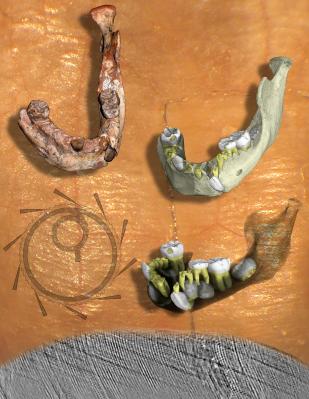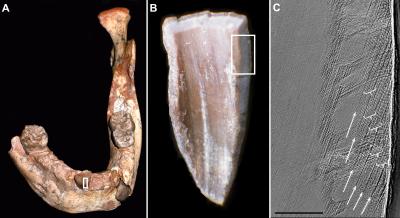- Home
- News
- General News
- Fossil from 160,000...
Fossil from 160,000 years ago shows growth profile similar to modern man
13-03-2007
PRESS RELEASE- An international team of scientists have found that the oldest member (160,000 years old) of the Homo sapiens species shows a life history profile similar to modern humans. These findings, based on experiments at ESRF, are in contrast to previous studies suggesting that early fossil humans possessed short growth periods, which were more similar to chimpanzees than to living humans.
Share
The origins of modern humans continues to be one of the most hotly debated topics among anthropologists, and there is little consensus about where and when the first members of our species, Homo sapiens, became fully modern. While fossil evidence tells a complex tale of mosaic change during the African Stone Age, almost nothing is known about changes in human 'life history', or the timing of development, reproductive scheduling, and lifespan. Research during the past two decades has shown that early fossil humans (australopithecines and early Homo) possessed short growth periods, which were more similar to chimpanzees than to living humans. However, it is unclear when and in which group of fossil humans the modern condition of a relatively long childhood arose.
The team of scientists examined the tooth growth and eruption in a fossil from an 8 year old child using the unique tool that is the X-rays beams of the ESRF. The fossil is from one of the earliest representatives of Homo sapiens. It was found in Jebel Irhoud, Morocco and was dated to approximately 160,000 years ago.
The scientists come from the Max Planck Institute for Evolutionary Anthropology (Germany), the Laboratory of Geobiology, Biochronology and Human Paleontology in Poitiers (France), the ESRF (France), the School of Dental Sciences in Newcastle (United Kingdom), the Research School of Earth Sciences in Canberra (Australia) and from the Department of Geology of the Mohammed V-Agdal University in Rabat (Marocco).
Tooth growth, and most importantly first molar tooth eruption age, represents one of the most powerful clues to reconstruct growth processes in fossil humans. By using incremental growth lines in teeth, similar to annual rings in trees, developmental rate and time may be accurately established millions of years after death.
The researchers used synchrotron light at the ESRF and combined a new application of a technique called phase imaging with developmental analysis. “It is the first non-destructive approach to characterize dental development with a high degree of precision, as synchrotron images reveal microscopic internal growth lines without damage to the sample”, explains Paul Tafforeau, one of the authors and developer of the virtual dental paleohistology using synchrotron light. Information on tooth growth in the Moroccan child was compared to other fossil and living human populations to determine if the modern condition of prolonged dental development was present.
These findings are not in contrast with our current wisdom that suggest that an extended period of development, and, by implication, childhood, may be linked to the origins of social, biological, and cultural changes needed to support dependent children with greater opportunities for early childhood learning.
Reference:
Tanya M. Smith, Paul Tafforeau, Donald J. Reid, Rainer Grün, Stephen Eggins, Mohamed Boutakiout, Jean-Jacques Hublin. Earliest Evidence of Modern Human Life History in North African Early Homo sapiens. PNAS March 2007





